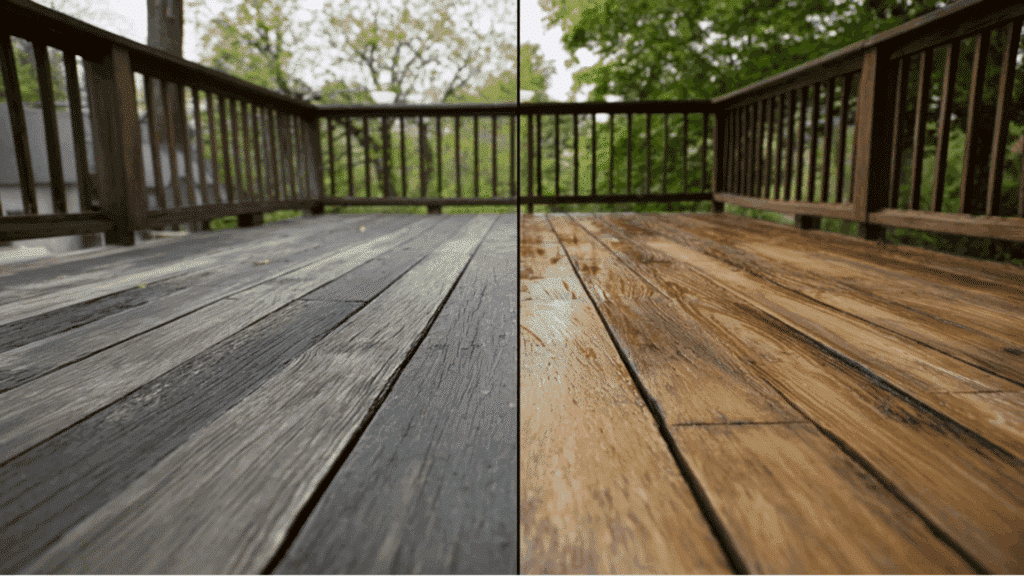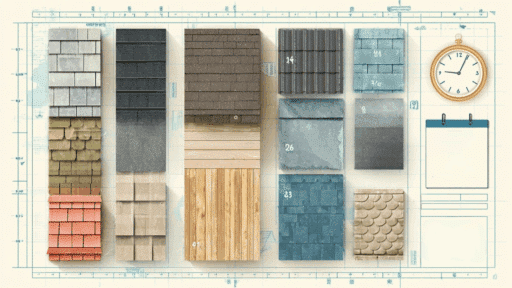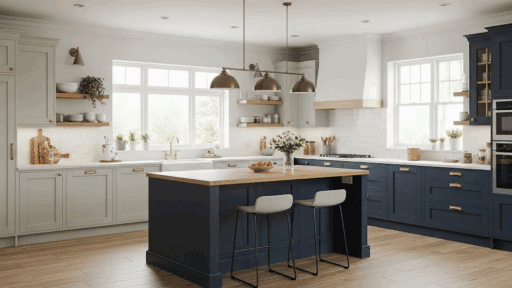I’ve been there, standing on my half-stained deck at 6 PM, realizing I’m three boards short of finishing and the store just closed. Ugh.
Buying too little stain means stopping mid-project and praying the next batch matches, while buying too much just wastes money.
And don’t get me started on how different wood types can throw off your estimates. One deck might need two gallons, another identical size needs three.
That’s why I swear by using a deck stain calculator now. I’ll show you exactly how to calculate your stain needs, ideally every time, and share the best online calculators I’ve actually tested. No more guessing, no more waste, no more panic trips to Home Depot.
Why You Need to Calculate Stain Requirements Accurately?
When I started staining my deck, I realized how important it is to calculate the right amount of stain.
Buying too little meant I had to stop halfway and hope the next batch matched, while buying too much was just a waste of money.
I also learned that different types of wood and the condition of the deck can affect how much stain gets absorbed.
Figuring it out ahead of time saved me time, stress, and effort. Now, I always measure my deck and check how much coverage the stain offers before heading to the store; it makes a big difference.
How Much Stain Do I Need for My Deck

Figuring out how much stain you need for your deck can be tricky, but it’s easy when you follow a few simple steps. Below, I’ve listed a brief to help you calculate it accurately:
1. Deck Size (Total Square Footage)
The most important factor is your deck’s total surface area. To calculate it, multiply the length by the width of each section (in feet).
Don’t forget to include railings, stairs, steps, spindles, and built-in seating; these can add 30–50% more surface area. The larger the area, the more stain you’ll need.
Example:
- Deck dimensions: 20 ft (L) × 12 ft (W) = 240 sq. ft.
- Adding 40% for stairs and railings: 240 × 1.4 = 336 sq. ft. total to stain
2. Type of Wood
Different types of wood absorb stain at different rates. Softwoods like pine or cedar are more porous and soak up more stain.
Hardwoods like oak or mahogany are denser and may require less. The more absorbent the wood, the more stain you’ll need.
Example:
- Wood type: Pressure-treated pine (a softwood)
- Coverage range for softwoods: 150–200 sq. ft. per gallon
- This means your 336 sq. ft. deck might need about 2 to 2.25 gallons for one coat
3. Condition of the Wood
The wood’s age and condition affect how much stain it will absorb. New, smooth lumber typically requires less stain, while older, weathered, rough, or dry wood will absorb more.
If the wood has been previously sealed or stained, it may resist new stain unless it’s properly stripped or sanded.
Example:
- Wood condition: 5 years old, never stained or sealed, and slightly rough
- High absorption expected → lower coverage, around 150 sq. ft. per gallon
- For 336 sq. ft.: 336 ÷ 150 = 2.24 gallons needed for one coat
4. Type of Stain Used
Different stains have different coverage levels:
- Transparent stains: typically offer the most coverage per gallon (up to 300 sq. ft.)
- Semi-transparent stains: offer moderate coverage (150–250 sq. ft. per gallon)
- Solid stains: provide the least coverage (often around 150 sq. ft. per gallon)
Always check the manufacturer’s label for exact coverage rates.
Example:
- Stain type: Semi-transparent
- Manufacturer’s label: Covers 200 sq. ft. per gallon
336 sq. ft. ÷ 200 = 1.68 gallons ( round off: 2 gallons for one coat)
5. Number of Coats Required
The number of coats you plan to apply directly impacts how much stain you’ll need. Some products are designed for a single coat, while others may recommend two coats for durability and color depth.
If you’re applying two coats, simply double your estimated quantity.
Example:
- You need 2 coats for durability
- First coat requires 2 gallons → 2 coats = 4 gallons total
Manual Formula to Estimate Stain (If You Prefer DIY)

If you’d rather calculate the stain yourself instead of using an online calculator, here’s a simple formula:
Total Stain Needed (gallons) = Coverage per Gallon (sq. ft.) ÷ Total Stainable Area (sq. ft.)×Number of Coats
Measure your deck’s area (length × width), add 30–50% for extras, check stain coverage (typically 150–300 sq. ft./gal), and multiply by the number of coats needed (usually 1 or 2).
Example 1: Small Deck (One Coat)
- Deck size: 12 ft × 10 ft = 120 sq. ft.
- Add 40% for extras: 120 × 1.4 = 168 sq. ft. total
- Stain coverage: 200 sq. ft. per gallon
- Number of coats: 1
Buy 1 gallon: 168÷200×1=0.84 gallons
My Top Recommended Online Calculators
When I was planning my deck staining project, I found that using a stain calculator made everything much easier.
These tools helped me figure out how much stain I needed, based on my deck size, wood type, and number of coats, so I didn’t overbuy or run out halfway through.
Here are four working deck stain calculators I personally tested and found reliable:
| Calculator | My Experience | Link |
|---|---|---|
| Omni Calculator | This one guided me through floor, railing, and step dimensions, and even let me adjust stain coverage per gallon, super precise! | Omni Calculator – Deck Stain |
| A2Z Calculators | I liked how easy it was to input dimensions and number of coats; clear, accurate, and free to use. | A2Z Deck Stain Calculator |
| Designing Idea | With an intuitive interface and helpful tooltips, I could easily input custom coverage rates and choose units. | Designing Idea – Stain Calculator |
| Woodworking Advisor | Straightforward and reliable, it entered my deck size and provided a precise gallons estimate, helping me avoid buying too much or too little. | Woodworking Advisor – Deck Stain Calculator |
Common Mistakes to Avoid When Estimating Stain
When I first estimated stain for my deck, I thought it was simple, but I quickly learned how easy it is to make mistakes that cost time and money.
Here are the most common ones I now always watch out for:
1. Not measuring railings and stairs: These areas add significant surface area and are often
forgotten.
2. Ignoring wood condition: Old, weathered, or rough wood soaks up more stain than new or smooth boards.
3. Using generic coverage rates: Coverage varies by stain type and brand; always check the product label.
4. Forgetting the number of coats: If your project needs two coats, double your stain estimate.
5. Not rounding up: Buying exact amounts can leave you short; round up to avoid mid-project delays.
6. Overlooking wood type: Softwoods like pine absorb more stain than hardwoods like oak or mahogany.
Conclusion
Now you’ve got the complete playbook for nailing your stain estimates every time.
From measuring your deck correctly (don’t forget those railings!) to factoring in wood type and condition, you know exactly what affects coverage. That deck stain calculator I recommended? It’ll save you from my 6 PM nightmare.
You’re armed with the formula, the best online tools, and you know the mistakes that trip up most DIYers. No more guesswork, no more waste.
Grab your measuring tape, pick one of those calculators, and get your stain estimate locked down before you hit the store. How did your stain project turn out? Drop a comment and let me know if these tips saved your sanity!








